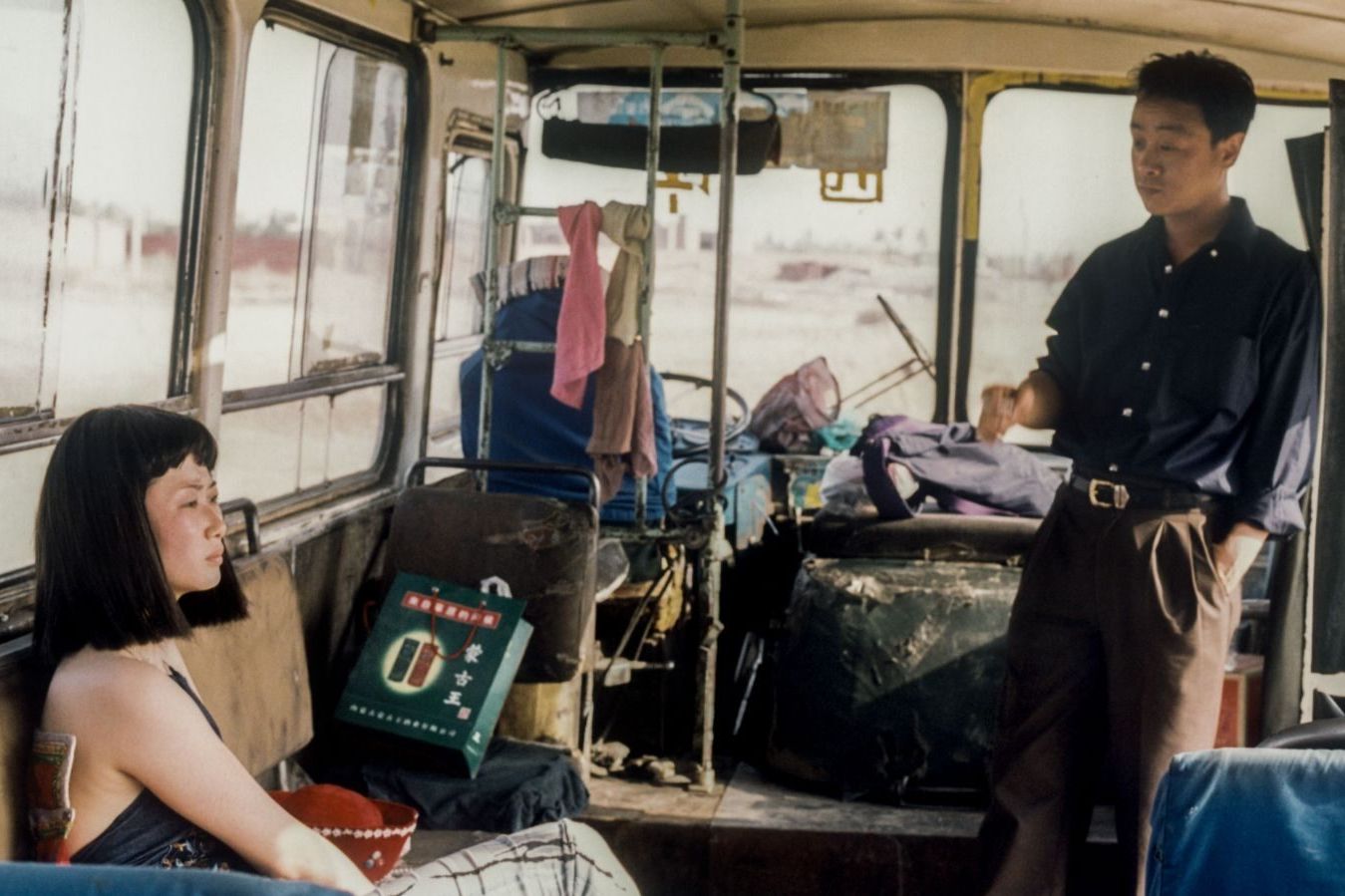

The man tells the woman he’s leaving. The woman runs out in tears. Though neither speaks a word, we read his message to her in a title card: “I want to leave and have a try outside. Once I get settled I’ll come to fetch you.” A train pulls out of the station, heading south with him on it. The woman stays alone in their dusty and arid hometown, smokes, and goes to work, singing onstage for an audience of men.
These early scenes from Jia Zhangke’s Caught by the Tides, between the departing Bin (Li Zhubin) and his girlfriend Qiaoqiao (Zhao Tao), sketch the same frame used to mount so many westerns: There’s the man who sets out for the frontier, and the woman he leaves behind. And as in many of Jia’s films, Bin and Qiaoqiao’s small story is the through-line for something that moves far beyond them. Jia, who’s one of the best-known Chinese filmmakers still working in his home country, has spent more than 25 years making movies that set the delicate ties between lovers, families, and friends against the large-scale thrill and brutality of China’s hurtle into the 21st century. In his work, dams are built, towns are razed, and high-rises shoot into the sky. Often, his real subject is who or what gets sloughed away in the process — the elders who can’t keep pace, the workers abandoned by their government, the old songs everyone can feel themselves starting to forget. Caught by the Tides is one of his most all-encompassing films yet, because of how it was made: He and his editors constructed most of it out of two decades of B-roll and documentary footage captured while working on other projects, from 2001 to 2022. Only the last section, shot during the pandemic, was created expressly to serve this story. Out of this grab bag of vérité and offcuts, Jia builds an epic. Or is it more of a eulogy?
The film takes its time to introduce its protagonists. It opens with a series of unrelated documentary scenes, lingering in a field, then peering into the domestic space of some women workers who laugh and roast one another while they take turns singing old folk songs and ballads. It’s 2001 in Datong, a city in the coal-mining province of Shanxi. A more capitalist China is revealing itself — Beijing has just won its bid for the 2008 Olympics; soon the country will join the World Trade Organization — and when Qiaoqiao finally appears, she looks like an envoy from that future, picking her away along derelict streets in a bob wig, tight pants, and kitten-heeled mules. Zhao has been working with Jia since the late ’90s (and married him in 2011), and her quick, precise physicality carries the film — because her character doesn’t have a single line of dialogue. Whether Qiaoqiao is running around town performing various hot-girl jobs, such as modeling to promote a new mall or shaking it at the club to trashy Euro dance, she is agile and receptive, ready for the new. Bin, when we finally see him, almost seems to resent her openness: While she spins on the dance floor, he slouches, smoking, on the sidelines. He will leave town soon after.
Jia intercuts this early section with documentary scenes of young people dancing at Chinese discos, going wild with pleasure in a way their parents, who toiled through the Cultural Revolution, could not have imagined. In China, the generation gap yawns wider than it does in the U.S.; so much changed so quickly in the past few decades that just moving between neighborhoods in a Chinese city can feel like time travel, from glossy new development to courtyards unchanged for a century. But you don’t have to know that to grasp the delirium of this era. Jia sets his dancers’ shimmies to the Danish earworm “Butterfly” that had an interminable half-life as the default song preloaded on Chinese cell phones and junky off-brand children’s toys. This youthful madness stops short when the film leaps into 2006: Here’s Qiaoqiao again, older and more soberly dressed in khakis and a polo shirt, on a ferry through the Three Gorges in southern China. We see her text Bin, her message shown again as a title card onscreen: “I am here from Datong looking for you.”
At which point you might realize: We have been here before. Because if you saw Jia’s last film, 2018’s Ash Is Purest White, you have. That film is also about a woman named Qiao who goes looking for her boyfriend Bin and used many of the same settings and even some of the same shots. But Jia’s footage of this particular scenery is even older than that: His team captured it while shooting his 2006 film Still Life, in which Zhao played, again, a woman looking for a man named Bin. (The 2001 scenes were shot during the production of 2002’s Unknown Pleasures.) Although the bits-and-pieces creation of Caught by the Tides has been touted as a rare process for Jia, he often returns to old footage in his work, either cutting it in directly or using it to inspire new story lines. He refuses to leave the past alone, and the fact that he’s now used the Three Gorges in multiple films tells us something about his fixations. He keeps returning to the scene of what he might just consider a crime: In 2006, the town of Fengjie — the setting for much of Still Life (and Ash, and Caught by the Tides) — was being slowly subsumed by rising water levels from the Three Gorges Dam project. Millions of people were displaced by the creation of the largest dam in the world. Entire counties and histories were lost forever. In Caught by the Tides, Jia lingers on documentary scenes of forced migrants from the area waiting for a ferry. Some carry TVs; others tote belongings in woven baskets worn like backpacks. “We’re doing this for our country,” one tells the camera. An announcer on Qiaoqiao’s ferry spells it out: “Some beautiful scenery will be underwater and ruined.”
Jia’s recycling is not haphazard or mistaken. He’s an artist squeezing all the juice from his lemon: How many different ways can he show us that China’s development is leaving people behind? We also feel his confidence that Zhao, in every film, brings enough of herself to carry multiple characters. His reediting and reuse of her performances is a marvel. In Ash Is Purest White, he used his footage to portray her Qiao as outspoken and street-smart, a straight shooter who simply cannot be had (except, unfortunately, by Bin). Working with the same reserve for Caught by the Tides, he now casts her as a silent observer whose lack of editorializing allows us to see through her eyes. Jia uses every bit of what Zhao gives: the shift in thought she signals with the widening of her eyes or a merry smile, a stiffening of the shoulder or darkening of the brow. While two-bit gangster Bin remains wrapped up in his own schemes (we learn that he’s spent his years in Fengjie tangling himself in a corruption scandal), Qiaoqiao gazes outward. We watch her watch the old world get erased.
Qiaoqiao accepts what’s happening around her. But her apparent passiveness is not as tragic as Bin’s self-involvement. In the film’s final section, shot in the masked-up environs of 2022, we are reintroduced to Bin on a plane. He is now gray-haired and dependent on a cane, washed out and exhausted. He never earned stability from his shady business dealings and has been forced to travel again in search of work. When he finally ends up back in Datong, he runs into Qiaoqiao. The dusty streets where the two once strutted are unrecognizable, filled up with KFCs and McDonald’s and young people who never learned the old revolutionary songs. When Bin and Qiaoqiao reunite, it feels like the first time they’re seeing one another clearly — and Qiaoqiao seems the most at ease. Bin offers not apologies but explanations. “I moved back. There weren’t many opportunities out there,” he tells her. She still doesn’t say a word. There’s more lost between them than any sentence could hold. There’s no home to return to at the end of this odyssey that is no more or less than life in China in the first two decades of the 21st century. It’s both as crazy and as normal as that.

Latest News
For Sale! 2016 Sea Ray 350 Sundancer – $180,000
Reel Deal Yacht is pleased to feature a meticulously maintained 2016 Sea...
Students spearhead disability sports initiative at local high school – SRU News
Changing Perceptions Through Inclusion: SRU Students Engage with Local High School In...
Pope Leo XIV is a White Sox fan — and the organization is embracing the occasion
It’s the biggest victory for the struggling Chicago White Sox in a...
Jasson Dominguez hits 3 homers to lead the Yankees past the Athletics 10-2
Jasson Dominguez hit three homers and drove in seven runs to lead...
Ohtani hits 3-run homer in 9th to cap Dodgers’ wild comeback in 14-11 win over Diamondbacks
Shohei Ohtani hit a three-run homer to cap a six-run ninth inning...














Leave a comment